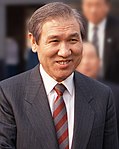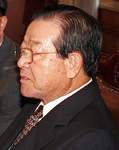1988 South Korean legislative election
| |||||||||||||||||||||||||||||||||||||||||||||||||||||||||||||||||
All 299 seats to the National Assembly 150 seats needed for a majority | |||||||||||||||||||||||||||||||||||||||||||||||||||||||||||||||||
|---|---|---|---|---|---|---|---|---|---|---|---|---|---|---|---|---|---|---|---|---|---|---|---|---|---|---|---|---|---|---|---|---|---|---|---|---|---|---|---|---|---|---|---|---|---|---|---|---|---|---|---|---|---|---|---|---|---|---|---|---|---|---|---|---|---|
| Turnout | 75.77% ( | ||||||||||||||||||||||||||||||||||||||||||||||||||||||||||||||||
| |||||||||||||||||||||||||||||||||||||||||||||||||||||||||||||||||
| |||||||||||||||||||||||||||||||||||||||||||||||||||||||||||||||||
| This article is part of a series on |
 |
|---|
|
|
Legislative elections were held in South Korea on 26 April 1988.[1] The result was a victory for the ruling Democratic Justice Party (DJP), which won 125 of the 299 seats in the National Assembly. Voter turnout was 75.8%. This was the first time the ruling party did not win a majority in the National Assembly since 1960, the first free and fair elections in Korean history. In January 1990, the DJP merged with other two opposition parties, leaving the Kim Dae-jung-led Peace Democratic Party to be the sole opposition party.
Electoral system
[edit]Of the 299 seats, 224 were elected in single-member districts via first-past-the-post voting, while the remainder were allocated via proportional representation at the national level among parties that won five or more seats in constituencies. One-half of those seats would be awarded to the top party (which was then eliminated from further consideration for national seats), with the remainder allocated based on vote share.
Political parties
[edit]| Parties | Leader | Ideology | Seats | Status | ||
|---|---|---|---|---|---|---|
| Last election | Before election | |||||
| Democratic Justice Party | Roh Tae-woo | Conservatism | 149 / 276
|
160 / 276
|
Government | |
| Reunification Democratic Party | Kim Myeong-yun | Liberalism | Did not exist | 50 / 276
|
Opposition | |
| Peace Democratic Party | Park Yeong-suk | 22 / 276
|
Opposition | |||
| New Democratic Republican Party | Kim Jong-pil | Conservatism | 9 / 276
|
Opposition | ||
| Democratic Korea Party | Yu Chi-song | Liberalism | 59 / 276
|
0 / 276
|
Opposition | |
| New Korean Democratic Party | Shin Do-hwan | 32 / 276
|
0 / 276
|
Opposition | ||
| Korean National Party | Lee Man-sup | Conservatism | 25 / 276
|
0 / 276
|
Opposition | |
| New Socialist Party | Socialism | 1 / 276
|
Dissolved | Opposition | ||
| New Democratic Party | Ryu Gap-jong | Liberalism | 1 / 276
|
Dissolved | Opposition | |
The governing Democratic Justice Party (DJP) had recently elected President Roh Tae-woo. While remaining the largest party, the DJP lost its absolute parliamentary majority. The party was hindered by a stronger opposition and the unpopularity of former party leader and President Chun Doo-hwan.
The opposition Peace Democratic Party led by veteran opposition leader Kim Dae-jung became the second largest party, winning more seats than another opposition Reunification Democratic Party (RDP). This was vindication for Kim Dae-jung, who came had come third in the 1987 South Korean presidential election. However, the election also showed the party's limitations, coming in as third place after DJP and RDP in popular vote and only winning seats in the Honam and Sudogwon, and nowhere outside of them.
For Kim Young-sam's Reunification Democratic Party the election was a major setback, winning third most seats in the parliament. This was after Kim had placed second in the first democratic presidential election, just ahead of Kim Dae-jung.
The New Democratic Republican Party (NDRP) led by former prime Minister Kim Jong-pil came a distant fourth. However, thanks to the failure of the DJP to win an absolute majority, the oppositions emerged as the major powerbrokers in the new National Assembly.
In January 1990, the DJP merged with the parties of Kim Young-sam and Kim Jong-pil to form the Democratic Liberal Party, with the former becoming its nominee in the 1992 presidential elections.
There were 224 constituency seats and 75 at large seats elected from lists in proportion to parties' share of constituency seats.
Results
[edit]| Party | Votes | % | Seats | |||||
|---|---|---|---|---|---|---|---|---|
| FPTP | List | Total | +/– | |||||
| Democratic Justice Party | 6,670,494 | 33.96 | 87 | 38 | 125 | –23 | ||
| Reunification Democratic Party | 4,680,175 | 23.83 | 46 | 13 | 59 | New | ||
| Peace Democratic Party | 3,783,279 | 19.26 | 54 | 16 | 70 | New | ||
| New Democratic Republican Party | 3,062,506 | 15.59 | 27 | 8 | 35 | New | ||
| Hankyoreh Democratic Party | 251,236 | 1.28 | 1 | 0 | 1 | New | ||
| People's Party | 65,650 | 0.33 | 0 | 0 | 0 | New | ||
| Korean National Party | 65,032 | 0.33 | 0 | 0 | 0 | –20 | ||
| New Korean Democratic Party | 46,877 | 0.24 | 0 | 0 | 0 | –67 | ||
| Democratic Korea Party | 32,799 | 0.17 | 0 | 0 | 0 | –35 | ||
| Korean Justice Party | 25,433 | 0.13 | 0 | 0 | 0 | New | ||
| The Third Generation Party | 16,148 | 0.08 | 0 | 0 | 0 | New | ||
| Hanist Reunification Korean Party | 3,736 | 0.02 | 0 | 0 | 0 | New | ||
| Unificational Socialist Party | 3,267 | 0.02 | 0 | 0 | 0 | New | ||
| Christian Holy People's Party | 2,247 | 0.01 | 0 | 0 | 0 | New | ||
| Independents | 933,161 | 4.75 | 9 | 0 | 9 | +5 | ||
| Total | 19,642,040 | 100.00 | 224 | 75 | 299 | +23 | ||
| Valid votes | 19,642,040 | 98.95 | ||||||
| Invalid/blank votes | 208,775 | 1.05 | ||||||
| Total votes | 19,850,815 | 100.00 | ||||||
| Registered voters/turnout | 26,198,205 | 75.77 | ||||||
| Source: IPU, Nohlen et al. | ||||||||
By city/province
[edit]| Region | Total seats |
Seats won | |||||
|---|---|---|---|---|---|---|---|
| DJP | PDP | RDP | NDRP | HDP | Ind. | ||
| Seoul | 42 | 10 | 17 | 10 | 3 | 0 | 2 |
| Busan | 15 | 1 | 0 | 14 | 0 | 0 | 0 |
| Daegu | 8 | 8 | 0 | 0 | 0 | 0 | 0 |
| Incheon | 7 | 6 | 0 | 1 | 0 | 0 | 0 |
| Gwangju | 5 | 0 | 5 | 0 | 0 | 0 | 0 |
| Gyeonggi | 28 | 16 | 1 | 4 | 6 | 0 | 1 |
| Gangwon | 14 | 8 | 0 | 3 | 1 | 0 | 2 |
| North Chungcheong | 9 | 7 | 0 | 0 | 2 | 0 | 0 |
| South Chungcheong | 18 | 2 | 0 | 2 | 13 | 0 | 1 |
| North Jeolla | 14 | 0 | 14 | 0 | 0 | 0 | 0 |
| South Jeolla | 18 | 0 | 17 | 0 | 0 | 1 | 0 |
| North Gyeongsang | 21 | 17 | 0 | 2 | 2 | 0 | 0 |
| South Gyeongsang | 22 | 12 | 0 | 9 | 0 | 0 | 1 |
| Jeju | 3 | 0 | 0 | 1 | 0 | 0 | 2 |
| Constituency total | 224 | 87 | 54 | 46 | 27 | 1 | 9 |
| PR list | 75 | 38 | 16 | 13 | 8 | 0 | 0 |
| Total | 299 | 125 | 70 | 59 | 35 | 1 | 9 |
References
[edit]- ^ Dieter Nohlen, Florian Grotz & Christof Hartmann (2001) Elections in Asia: A data handbook, Volume II, p420 ISBN 0-19-924959-8
External links
[edit]- 1988 elections in South Korea Inter-Parliamentary Union


